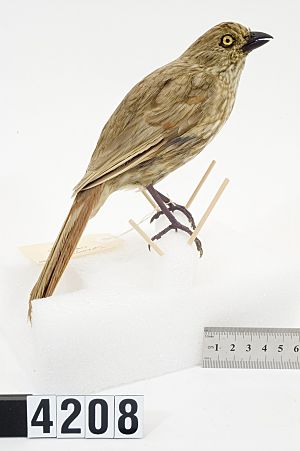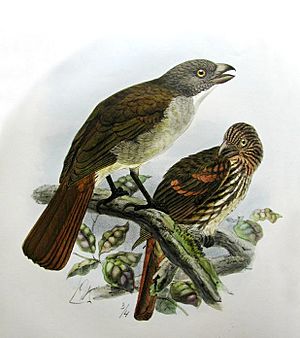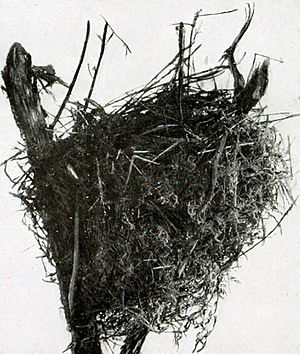South Island piopio facts for kids
Quick facts for kids South Island piopio |
|
|---|---|
 |
|
| Specimen in Auckland Museum | |
| Conservation status | |
| Scientific classification | |
| Genus: |
Turnagra
|
| Species: |
capensis
|
| Subspecies | |
|
See text |
|
| Synonyms | |
|
|
The South Island piopio (Turnagra capensis) was a unique bird from New Zealand. It was also known as the New Zealand thrush. This bird was a type of passerine bird, which means it was a perching bird. It belonged to the family Oriolidae. Sadly, the South Island piopio is now extinct, meaning it no longer exists anywhere in the world.
Contents
About the South Island Piopio

Scientists first described the South Island piopio in a group called Tanagra. Later, some thought it belonged to the Turdus group. For a long time, people thought the South Island piopio was the same species as the North Island piopio. Both lived in New Zealand.
However, scientists later realized they were different species. They looked closely at their bodies and found clear differences. This showed they were two separate kinds of piopio.
Piopio Subspecies
There were two known types, or subspecies, of the South Island piopio:
- †T. c. capensis - This was the main type. It lived on the South Island of New Zealand.
- Stephens Island piopio (†T. c. minor) - This smaller type lived only on Stephens Island. Stephens Island is a small island near the main South Island.
Scientists once thought the Stephens Island piopio might just be a young bird. But they later confirmed it was a real, distinct subspecies. It's interesting because the piopio didn't usually fly to offshore islands. Yet, a special group of them lived on Stephens Island.
What the South Island Piopio Looked Like
This bird was about medium-sized. Its body was mostly olive-brown. Its wings and tail were a reddish-brown color. The bird also had a speckled pattern on its chest.
The Stephens Island piopio was much smaller than the main South Island type. Many people believed the South Island piopio had one of the most beautiful songs of all native New Zealand birds.
How the South Island Piopio Lived
South Island piopios ate many different things. They were omnivores, meaning they ate both plants and small animals. These birds were also quite brave around people. There are stories of them taking food scraps from campers.
Why the South Island Piopio Disappeared
The South Island piopio used to be common in the forests of New Zealand's South Island. But around 1863, their numbers started to drop. The population quickly declined in the 1880s.
The main reasons for their disappearance were new animals brought by humans. Cats and rats were introduced to the island. These new predators hunted the piopios. Also, some of their forest homes were destroyed.
By 1888, people said the piopio was one of the rarest birds in New Zealand. By 1905, it was almost completely gone. The last confirmed bird was seen in 1902. However, some people reported seeing them later. The last possible sighting was in 1963.
The Stephens Island Piopio Disappears
The Stephens Island piopio also became extinct. This happened around 1897. Feral cats, which are wild cats, caused their extinction. Hundreds of these cats lived on the island by then. You can read about Lyall's wren for a similar story.
The very last specimen of the Stephens Island bird was collected on January 7, 1897. By the end of 1898, there were no more left. Today, only 12 specimens of the Stephens Island piopio exist in museums around the world. These include museums in Dresden, London, Liverpool, Toronto, Pittsburgh, and Bremen.
Images for kids
-
North Island piopio in front, South Island piopio at rear.
See also
 In Spanish: Piopio de isla Sur para niños
In Spanish: Piopio de isla Sur para niños




